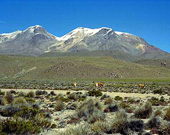-Main Square, city of Arequipa
Bordered by various arched walkways and the Cathedral, the Main Square possesses a beautiful bronze fountain of three plates crowned by the figure of a sixteenth century soldier. Of this person, who is called Tuturutu, the story says he was in charge of warning of any new event. Around the square, you see three granite portals with brick and lime bases: Portal del Cabildo (Portal de la Municipalidad), Portal de las Delicias (Portal de San Agustín), and Portal del Regocijo (Portal de Flores).
-Cathedral, city of Arequipa
Main Square . Telephone: (054) 23-2635 / 40-5393. Visiting hours: Mon. Sat. 7:00 A.M. 11:30 A.M. and 5:00 P.M. 7:30 P.M. , Sundays 7:00 A.M. 1:30 P.M. and 5:00 P.M. 7:00 P.M.
It is considered one of the first seventeenth century religious monuments of the city. It is built of sillar (white volcanic stone) with a brick base. Destroyed by fire in 1844, it was rebuilt in 1868 by the Arequipa architect Lucas Poblete. He used a Neoclassical style and placed the entrances of church on the flanking naves. In 2001, the building was struck hard by an earthquake, which seriously damaged its towers.
-Iglesia de La Compañía and complex (The Church of the Company of Jesus Christ)
Intersection of Calle General Morán and Calle Álvarez Thomas, Main Square.Visiting hours: Mon. Sun. 9:00 A.M. 11:00 A.M. and 3:00 P.M. 6:00 P.M.
This complex, made up of buildings constructed by the Jesuits for religious and living purposes, is a representative monument of the seventeenth century religious architecture (1660). The church itself rises from the center of the buildings. It was designed in 1573 by Gaspar Baez and destroyed by an earthquake in 1584. The current structure dates from 1650. Inside you find sixty-six canvases from the CuscoSchool from such artists as Bernardo Bitti and Diego de la Puente.
Monasterio de Santa Catalina (Saint Kathleen Monastery)
Calle Santa Catalina 301. Visiting hours: Mon. Sun. 9:00 A.M. 4:00 P.M.
Constructed to shelter the daughters of the wealthiest families of the city with a religious vocation, the monastery was inaugurated on October 2, 1580, under the name of Santa Catalina of Siena to be a totaly cloistered religious center, and it remained that way until August 15, 1970.
It occupies an approximate area of 20.000 m2 (215.285 feet2), and its placement is similar to the first neighborhoods of Arequipa. The building exhibits rooms of very different architectural design. One of the areas has been established as a gallery to display the canvasses of the Cusco, Quito, and ArequipaSchools. There are other rooms, or sectors, to visit as well, like el Claustro de la Portería (the Gate Cloister), el Museo Precolombino (the pre-Colombian Museum), el Claustro de San Francisco (the Cloister of Saint Francis), etc.
-Iglesia de San Francisco and complex ( Church of Saint Francis )
First block of Calle Zela. Telephone: (054) 22-3048. Church visiting hours: Mon. Sat. 7:00 A.M. 9:00 A.M. and 5:00 P.M. 8:00 P.M. Sundays 7:00 A.M. 12:00 P.M. and 5:00 P.M. 8:00 P.M. Convent visiting hours: Mon. Sat. 9:00 A.M. 12:30 P.M. and 3:00 P.M 5:00 P.M.
The complex contains the Saint Francis church, the convent and a smaller church known as La Tercera Orden (the Third Franciscan Order). What catches the attention inside the church is the bas-relief decorated Baroque pulpit and the silver front of the main altar. Besides these, a short passageway, named Manguillo de San Francisco , has been added to the complex to separate the church from what was the first girl school and later a women jail. Today, it has become a commercial art center known as Fundo El Fierro (Iron Ranch).
-Convento de La Recoleta (La Recoleta Convent)
Jiron Recoleta 117. Telephone: (054) 27-0966. Visiting hours: Mon. Sat. 9:00 A.M. 12:00 P.M. and 3:00 P.M. 5:00 P.M.
A Franciscan convent founded in 1848, open to the public since 1978. It features various styles that include Romantic and Neo-gothic styles due to its different remodeling campaigns (the last one in 1940). It has four cloisters and eleven sectors, as well as two pre-Colombian art rooms, two others dedicated to the AmazonRain Forest, and another to religious art. It also has a gallery exhibiting canvasses from the Cusco and ArequipaSchools and a valuable library that protects more than 20.000 volumes and ancient books.
-Iglesia y Convento de Santo Domingo (Church and Convent of Santo Domingo )
Intersection of Calle Santo Domingo and Calle Rivero. Telephone: (054) 21-3511. Visiting hours: Mon. Sat. 7:00 A.M. 12:00 P.M. and 3:00 P.M. 7:30 P.M. Sundays 5:45 A.M. 1:00 P.M. and 6:30 P.M. 7:45 P.M.
Architecturally, the church is characterized by a bell tower, its entrance with a corner pedestal, and its impeccable arch under the choir loft. Inside, one can appreciate paintings and other pieces of sacred art.It is also known for its side entrance being the oldest in Arequipa . The upper cloister of the convent was constructed around 1734.
-Casa del Moral (Moral House)
Calle Moral 318, downtown Arequipa . Visiting hours: Mon. Sat. 9:00 A.M. 5:00 P.M. Holidays 9:00 A.M. 1:00 P.M.
An eighteenth century house, constituting one of the oldest and most important architectural monuments from the Arequipa Baroque period. The house owes its name to an ancient blackberry tree that grows in its main patio. Inside, furniture from Peru's Colonial and Republican epochs is on display. The main entrance of white sillar stone is a work of art in which you can admire carefully carved figures. For example, there is a crown suspended above a coat of arms that is held up by two angels, the coat of arms is composed of tinier carvings of a castle, a bird, a puma, and two crossed keys. In the same way, the room of sixteenth century antique maps of America stands out.
-Barrio de San Lázaro (Saint Lazarus neighborhood)
Five blocks from the Main Square , Arequipa .
This neighborhood of alleys, narrow passageways, small plazas, and large homes is the most representative of old Arequipa. This place was established by Dominican priests in 1538, who built a sanctuary to evangelize the natives of the area and prepare the land to found a new Spanish city. The small bridge that connects the Church of San Lázaro and its small plaza with the rest of the quarter is worth a visit.
-Casa Goyeneche (Goyeneche House)
Calle La Merced 201. Telephone: (054) 21-2251. Visiting hours: Mon. Fri. 9:15 A.M. 3:00 P.M.
This sixteenth century house of white sillar stone is completely designed in the Colonial style. Prints from the Cusco and ArequipaSchools are preserved thereas well as sculptures from the GranadaSchool of the seventeenth century. The name comes from Mr. Juan de Goyeneche y Aguerreverre, who bought it in 1782. Presently, it is headquarters to the Central Reserve Bank of Peru in Arequipa.
-Iglesia San Agustín (Saint AugustineChurch)
Intersection of Calle San Agustín and Calle Bolívar. Telephone: (054) 22-0066. Visiting hours: Mon. Sat. 8:00 A.M. 12:00 P.M. and 5:00 P.M. 7:00 P.M. Sundays 8:00 A.M. 1:00 P.M. and 5:00 P.M. 7:00 P.M.
Built in 1575, the church displays a façade that dates from the first half of the eighteenth century and is considered one of the best of its time. In architectural terms, it belongs to the mixed-origin Baroque and the main construction material is white sillar stone. Inside, the main highlights are the dome, its Neoclassical altars, especially the major one, for the precise carvings and gilding
-Iglesia La Merced ( Mercy Church )
Intersection of Calle La Merced and Calle Tristán. Telephone: (054) 21-3233. Visiting hours: Mon. Fri. 8:00 A.M. 1:00 P.M. and 4:00 P.M. 7:00 P.M. Saturdays 8:00 A.M. 12:00 P.M.
Its construction began in 1551 and was completed in 1607. It has an attractive side entrance, which features the image of the Virgin of Mercy accompanied by two saints of mercy. Important works of art like the Aparición de la Virgen a San Pedro Nolasco (Saint Peter Nolasco Recovering the Image of the Virgin) are preserved in its sacristy as well as a series of paintings related to the Virgin de la Merced in the main hall. The church and the convent, the latter constructed in the city, were built using the white sillar stone from Arequipa . The cloister maintains a library that dates back to the Vice royal period.
-Casa Tristán del Pozo (Tristán del Pozo house)
Calle San Francisco 108. Telephone: (054) 21-2209. Visiting hours: Mon. Fri. 9:15 A.M. 12:45 P.M. and 4:00 P.M. 6:00 P.M. Saturdays 9:30 A.M. 12:30 P.M.
This traditional, colonial house has a façade carved in mixed-origin Baroque. In addition, it was made with wide, unique patios inside. It was built in 1738 for General Domingo Tristán del Pozo. Today, it is the property of Banco Continental.
-Museo Arqueológico de la Universidad de San Agustín
( University of San Agustín Archeological Museum )
Intersection of Calle Álvarez Thomas and Calle Palacio Viejo. Telephone: (054) 28-8881. Visiting hours: Mon. Fri. 8:15 A.M. 4:15 P.M.
A varied collection is exhibited here including stone items, bones from human sacrifices, ceramic pieces from the Nasca, Tiahuanaco , Huari, and Inca, and objects of gold and silver from the Colonial and Inca eras.
-Museo de Arqueología de la Universidad Católica de Santa María de Arequipa ( University of Santa María de Arequipa Archeological Museum )
Calle Cruz Verde 303. Telephone: (054) 95-9636. Visiting hours: Mon. Fri. 9:00 A.M. 12:00 P.M. and 2:00 P.M. 5:00 P.M.
The museum has around 1000 pieces (ceramics, textiles, mummies, works of stone, wood, and metal) from the different cultural groups that inhabited the Department of Arequipa from 12.000 B.C. up to the time of the colony: Nasca, Tiahuanaco, Wari, Churajón, Acarí, Aruni and Inca as well as transitional and colonial materials.
-Museo Santuarios Andinos de la Universidad Católica de Santa María(Catholic University of Saint Mary)
Calle La Merced 110, downtown Arequipa. Telephone: (054) 21-5013. Visiting hours: Mon. Sat. 9:00 A.M. 6:00 P.M. Sundays 9:00 A.M. 3:00 P.M.
"The mummy, Juanita, will not be on exhibit from January to April each year because it will be going through a process of preservation."
Here, they exhibit la Dama de Ampato (the Lady of Ampato), an Inca mummy of a twelve to fourteen year old girl found at the top of the Ampato volcano by the climber Miguel Zárate, the archeologist José Chávez, and the anthropologist Johan Reinhard on September 8, 1995 . According to the specialists, it is very likely that the girl, whose remains were found frozen, died from a blow to the temple from a five pointed granite mace. It seems that she was sacrificed to the Ampato Apu (protector god) some 500 years ago.



